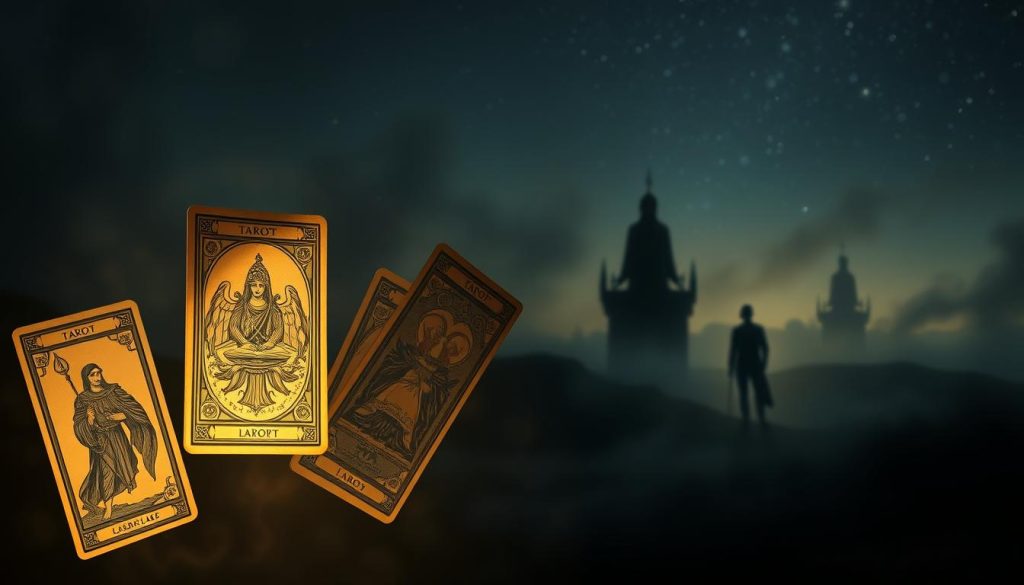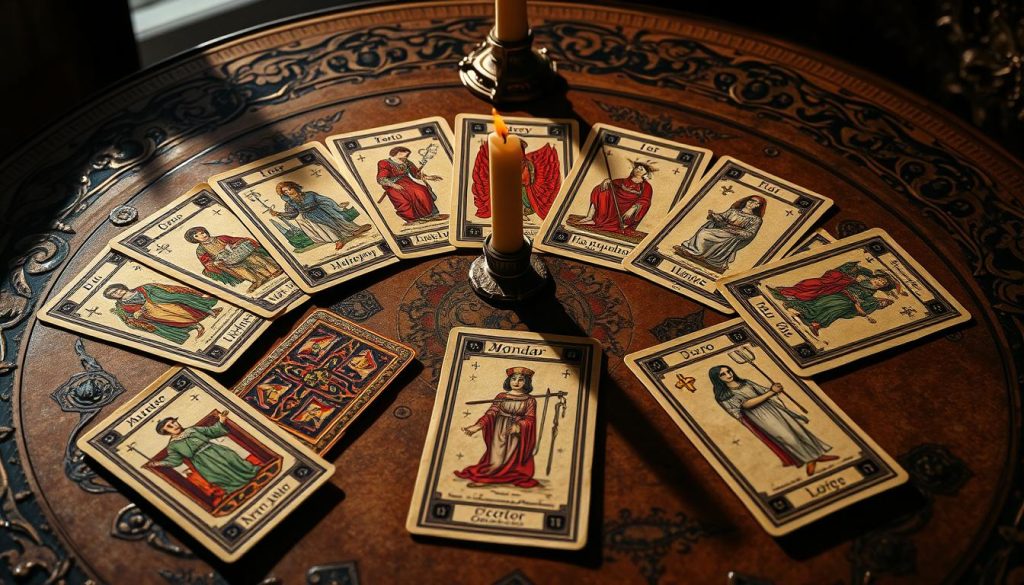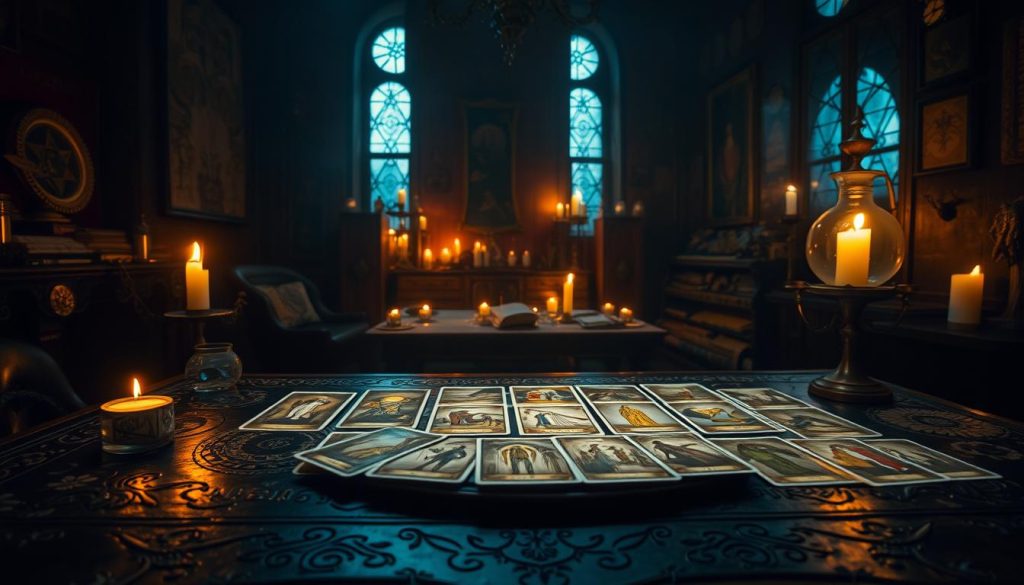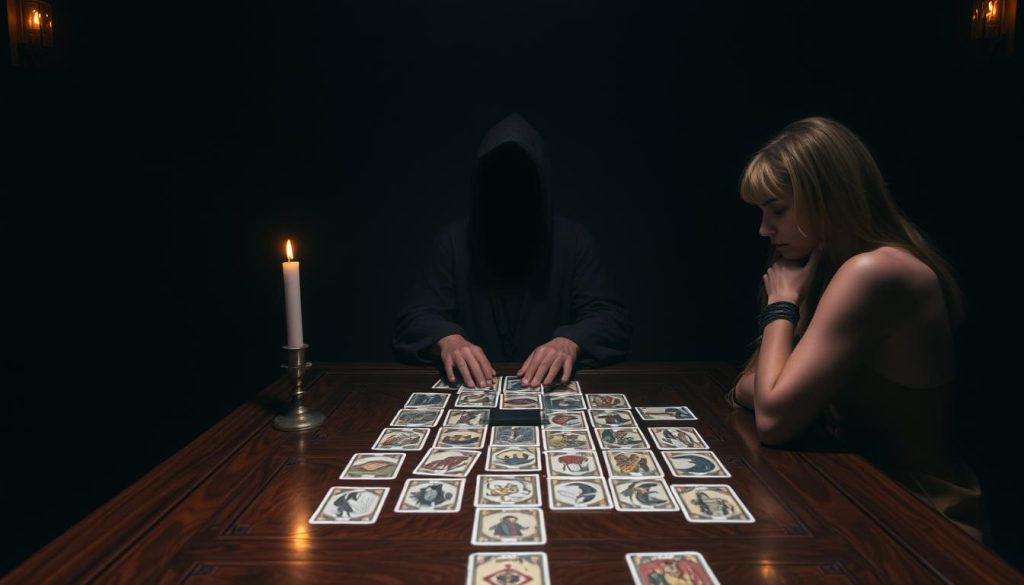We invite you on a short, warm tour from Italian court games to the apps we tap today. In the mid-15th century, hand-painted tarocchi decks appeared in Italy as elegant play. Noble families like the Visconti-Sforza commissioned luxury sets that mixed art and leisure.
The cards split into a Major Arcana of 22 archetypes and a Minor Arcana with four suits: Wands (fire), Cups (water), Swords (air), Pentacles (earth). That structure makes symbolism feel usable, not distant.
By the late 1700s, figures such as Jean-Baptiste Alliette reframed the deck for divination and personal exploration. This marked the key transformation from game toward spiritual tool.
Across the world today, people use decks for guidance and insights. Online communities and apps bring those images into daily practice. We’ll balance mythic wonder with practical tips, so the cards become companions for growth, not relics.
Setting the Stage: Why the History of Tarot Still Matters Today
Knowing where the cards come from makes each spread feel less like guesswork and more like conversation. When we tie old symbols to present concerns, a tarot reading becomes a clear tool for exploration, not a cryptic demand.
Tarot blends learned symbolism with intuition to tell a story shaped by a querent’s life. Modern access—social feeds, apps, and online communities—means more people learn gentle, ethical interpretations today.
We frame the deck as a practice for personal growth and better decisions. Simple rituals—journaling after a reading, mindful shuffles, or a short grounding breath—make card reading a lived habit.
Honoring the deck’s lineage keeps interpretations rooted and responsible. That history gives structure; intuition brings the nuance. Together they invite reflective readings that empower, not dictate.

Medieval Beginnings: Italian Tarocchi, Courtly Culture, and the First Tarot Decks
Tarocchi began in mid-1400s Italy as a stylish pastime, where gilded cards signaled rank and taste. These early tarot sets were luxury objects made for nobles in palace halls.

The famed Visconti-Sforza deck shows how painters fused art and allegory. Four suits and trump figures let players stage playful contests and display craftsmanship.
We trace the origins tarot moment as social first, not spiritual. For a long time, the cards served games and status, even as their symbols echoed the era’s beliefs.
Over centuries, these formats traveled across Europe. Decks evolved, and meanings layered on top. The switch to divination came much later.
Compare an early tarocchi set with a modern tarot deck: layout and many figures persist. A single card could move from play to personal mirror, shaping how we do card reading today.
Inside the Tarot: Major Arcana archetypes and the Minor Arcana’s everyday life
Major cards trace big arcs of identity; the Minor suits point to the small choices that shape each day. The Major Arcana’s 22 figures read like a mythic road map—from fresh starts to completion—and they mirror inner shifts and outer choices.

The Minor Arcana breaks into four suits tied to elements: Wands/fire, Cups/water, Swords/air, Pentacles/earth. These cards speak to daily work, love, thought, and money. Readers weave meanings into a spread to form a narrative tailored to a querent’s life.
Quick way to parse symbolism: note the element, the number, and the picture cues. That trio turns dense imagery into usable interpretations you can trust in a reading.
Try journaling prompts: “How does this archetype show up in my week?” or “What routine echoes this card?” A simple three-card spread—situation, support, step—helps the deck become a steady speaking partner.
Origins give structure, and our intuition colors the details. Together they make each tarot deck a living tool for fresh insights.
From Occultism to Personal Growth: How Divination Reframed the Cards
In the late 18th century a single manual helped flip decks from pastime to repeatable practice. Jean-Baptiste Alliette (Etteilla) published a full guide that systematized tarot card reading and spread practical methods for divination.

By the late 19th century, the Hermetic Order Golden—often called the Order Golden Dawn—wove astrology, Kabbalah, and alchemy into study. That era gave readers a common language of correspondences. It shaped how a tarot reading links planets, elements, and symbols.
The 20th century brought the Rider‑Waite‑Smith revolution. Pamela Colman Smith’s illustrated pips under A.E. Waite made narrative practice clearer. Suddenly cards told stories at a glance and learning a spread felt less mystic and more usable.
Across centuries the evolution made the deck a gentle tool for reflection and personal growth. We can blend those traditions with our own intuition. Try using one classical correspondence and one free association in a short reading. It keeps practice rooted, alive, and kind.
Tarot Crosses Oceans: European Esotericism to U.S. Popular Culture
When European occult teachings reached U.S. shores, the tarot quickly found new classrooms and parlor stages. In the late 19th and early 20th century, traveling lecturers, metaphysical shops, and print guides carried history tarot cards into American life.
Order Golden Dawn and the hermetic order golden currents shaped study groups and home circles. Parlor demonstrations turned card reading into public spectacle and private practice.
By mid‑century, New Age hubs popularized tarot card reading. Themed decks and accessible guides made a deck feel less rare and more playful. Teachers built classes, workshops, and media segments so more people could try a spread.
In the U.S., divination often mixed with psychology and wellness. Folks used readings as creative prompts, therapy adjuncts, and ritual for daily life. Regional communities, festivals, and online groups later localized these practices across the world.
Today, tarot keeps evolving. Its origins tarot and Golden Dawn ideas still inform many study circles. We find a living tradition that welcomes beginners and honors older forms.
History of Tarot: From Ancient Mystics to Online Readings
Today the deck’s images travel fast—appearing on feeds, apps, and video calls where practice meets play. Digital platforms link classic manuals with peer threads so study blends with community.
We honor the roots while embracing transformation. The evolution tarot shows how symbolism moves from painted panels to glowing screens. That shift keeps divination soulful, not mechanical.
Practical paths for beginners: daily pulls, live practice streams, and forums that give gentle feedback. These habits build confidence and deepen your personal connection to the art.
Choose decks by what resonates. Scan suits, note color palettes, and trust how a card asks your attention. Use readings as guidance and as prompts for reflection.
In time, you’ll track patterns and collect insights. Treat the deck as a kind tool personal for growth. We invite playful study, steady practice, and mindful use of what the cards share.
The Symbols Evolve: Modern Decks, Cultural Influence, and Personal Connection
Modern decks remix old emblems with new faces, bringing fresh stories to familiar cards. This evolution blends past structure with playful changes so a tarot deck feels both rooted and new today.
Rider‑Waite‑Smith helped by illustrating the minor arcana, which made narrative reading easier. Since then, themed and indie tarot decks have expanded cultural art and voice across years and places.
Want a quick personal check? Flip through images. Notice a tug in your chest. Let that pull guide which deck you keep. That instant builds a real personal connection.
For steady growth, rotate decks, log daily draws, and save spreads in a journal or app. Treat the deck as a tool personal; these practices help map meanings across time.
Communities and creators coevolve interpretations. Try simple exercises—spot a color, name a number, note an element—and keep play in your practice. Card reading ranges from spare prompts to story-rich sessions; choose what feels magical to you.
Tarot’s Timeless Thread: What the Past Reveals About Readings Today
The old frameworks in tarot steady practice while your instincts bring fresh meaning.
We tie history tarot to modern ritual: set intent, pull, reflect, act. Wait a few days and revisit to test any guidance you received.
Divination is a mirror, not an order. Treat the deck as a gentle tool personal for choices and personal growth.
Try one blend: note three striking images in an art tarot reading, then link them to your question. Use minor arcana cues for timing and tasks; majors show larger life arcs.
Breathwork, short journaling, and mindful pauses sharpen readings. Over years, patterns in card reading become trusted insights.
Let the cards be a companion rooted in history and alive in your hands today.
